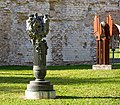
Altichiero da Zevio, also called Aldighieri da Zevio, was an Italian painter much influenced by Giotto, certainly through knowledge of the frescoes in the Cappella degli Scrovegni in Padua and quite possibly through having been trained in Florence by one of Giotto's pupils. Altichiero worked in Verona and Padua. Works by him survive in the church of Sant'Anastasia in Verona and in the Cappella di S Felice in the basilica of Sant'Antonio and the Oratorio di San Giorgio in Padua. His stature was compromised for a long time through his supposed collaboration with a certain Jacopo Avanzo or Avanzi, but study of the documents and historiography demonstrated Atichiero's authorship of the frescoes in both the Santo and the Oratorio di San Giorgio. It has been argued that the hand of an assistant can be seen in some early scenes in the Santo – although it was certainly Altichiero who was paid to decorate the chapel, and he received 792 ducats in the summer of 1379.

BartolomeoMontagna was an Italian Renaissance painter who mainly worked in Vicenza. He also produced works in Venice, Verona, and Padua. He is most famous for his many Madonnas and his works are known for their soft figures and depiction of eccentric marble architecture. He is considered to be heavily influenced by Giovanni Bellini, in whose workshop he might have worked around 1470. Benedetto Montagna, a productive engraver, was his son and pupil and active until about 1540. He was mentioned in Vasari's Lives as a student of Andrea Mantegna but this is widely contested by art historians.

The Gallerie dell'Accademia is a museum gallery of pre-19th-century art in Venice, northern Italy. It is housed in the Scuola della Carità on the south bank of the Grand Canal, within the sestiere of Dorsoduro. It was originally the gallery of the Accademia di Belle Arti di Venezia, the art academy of Venice, from which it became independent in 1879, and for which the Ponte dell'Accademia and the Accademia boat landing station for the vaporetto water bus are named. The two institutions remained in the same building until 2004, when the art school moved to the Ospedale degli Incurabili.
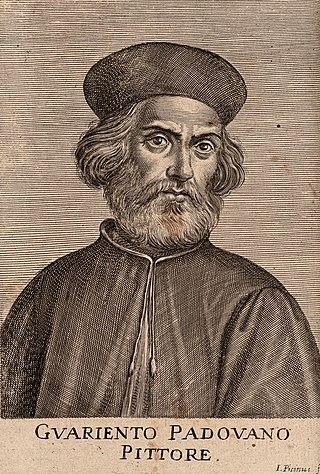
Guariento di Arpo, sometimes incorrectly referred to as Guerriero, was a 14th-century painter whose career was centered in Padua. The painter is buried in the church of San Bernardino, Padua.

The Scrovegni Chapel, also known as the Arena Chapel, is a small church, adjacent to the Augustinian monastery, the Monastero degli Eremitani in Padua, region of Veneto, Italy. The chapel and monastery are now part of the complex of the Musei Civici di Padova.

The Pinacoteca di Brera is the main public gallery for paintings in Milan, Italy. It contains one of the foremost collections of Italian paintings from the 13th to the 20th century, an outgrowth of the cultural program of the Brera Academy, which shares the site in the Palazzo Brera.

The Museo Correr is a museum in Venice, northern Italy. Located in St. Mark's Square, Venice, it is one of the 11 civic museums run by the Fondazione Musei Civici di Venezia. The museum extends along the southside of the square on the upper floors of the Procuratorie Nuove. With its rich and varied collections, the Museo Correr covers both the art and history of Venice.
The decade of the 1450s in art involved many significant events, especially in sculpture.

The Church of the Eremitani, or Church of the Hermits, is a former-Augustinian, 13th-century Gothic-style church in Padua, region of the Veneto, Italy. It is also now notable for being adjacent to the Cappella Scrovegni with Giotto frescoes and the municipal archeology and art gallery: the Musei Civici agli Eremitani, which is housed in the former Augustinian monastery located to the left of the entrance.

This article about the development of themes in Italian Renaissance painting is an extension to the article Italian Renaissance painting, for which it provides additional pictures with commentary. The works encompassed are from Giotto in the early 14th century to Michelangelo's Last Judgement of the 1530s.

The Madonna dell'Orto is a church in Venice, Italy, in the sestiere of Cannaregio.

Lamentation (The Mourning of Christ) is a fresco painted c.1305 by the Italian artist Giotto as part of his cycle of the Life of Christ on the interior walls of the Scrovegni Chapel in Padua, Italy.
Giuliano Pisani is a writer, classical philologist, scholar of ancient Greek and Latin literature, and art historian who was born on April 13, 1950, in Verona, Italy. He graduated with a degree in ancient Greek history from Padua University with Professor Franco Sartori. He was a full professor of Greek and Latin literature at Liceo Tito Livio in Padua. Since 2011, he has been a member of the National Italian Committee of the Promoters of Classical Culture at MIUR. He was also the technical coordinator of the first Olympiad in Classical Languages and Civilizations, which was held in Venice.
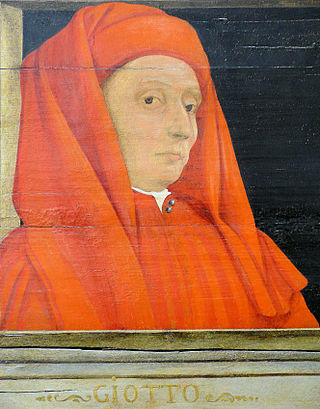
Giotto di Bondone, known mononymously as Giotto and Latinised as Giottus, was an Italian painter and architect from Florence during the Late Middle Ages. He worked during the Gothic and Proto-Renaissance period. Giotto's contemporary, the banker and chronicler Giovanni Villani, wrote that Giotto was "the most sovereign master of painting in his time, who drew all his figures and their postures according to nature" and of his publicly recognized "talent and excellence". Giorgio Vasari described Giotto as making a decisive break from the prevalent Byzantine style and as initiating "the great art of painting as we know it today, introducing the technique of drawing accurately from life, which had been neglected for more than two hundred years".
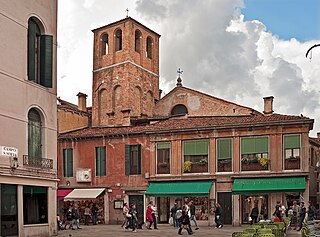
Santa Sofia is a church located in the sestiere (neighborhood) of Cannaregio in Venice, Italy. It should be distinguished from the palazzo Ca' d'Oro on the Grand Canal is also called the Palazzo Santa Sofia.

The Galleria Giorgio Franchetti alla Ca' d'Oro is an art museum located in the Ca' d'Oro on the Grand Canal in Venice, Italy.
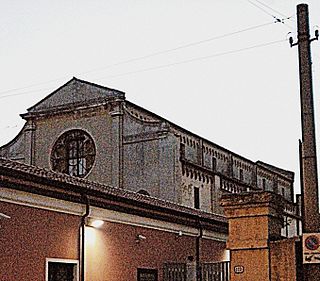
San Giovanni di Verdara or Saint John of Verdara is a former Roman Catholic monastery and church located on Via San Giovanni di Verdara # 123, in the city of Padua, region of Veneto, Italy. It was founded in 1221, but now serves as a military hospital, and is not accessible to the public.
The Diocesan museum of Padua displays arts and artifacts belonging to the Roman Catholic Diocese of Padua; it is housed in the 15th-century former bishop's residence or Palazzo Vescovile. The building, adjacent to the Cathedral of Padua, faces the Piazza del Duomo, can in the historic center of Padua, region of Veneto, Italy.

The Palazzo Zuckermann is a palace located on corso Garibaldi in Padua, Italy. The building now houses the collections of the Museo di arti applicate e decorative on the first floor and the Museo Bottacin on the second floor; these collections form part of the Civic Museum of Padua. It stands across the street from the Cappella degli Scrovegni and the Museo agli Eremitani; the latter houses the main art gallery of the civic Museum of Padua.










